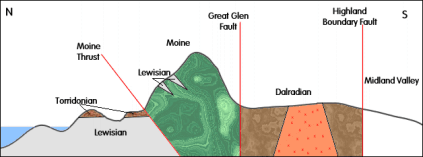Precambrian History of Scotland
About the author

Jon
Imperial College London
Introduction
The Precambrian of the UK is mainly located in northern Scotland, however there are outcrops in England and Wales also. The oldest rock constituents found there date to around 3450Ma and belong to the Lewisian complex. The Precambrian formations are (youngest to oldest):
- Dalradian
- Moine
- Torridonian
- Lewisian
The location of these formations is shown in Figure 1a and a sketch cross section is shown in Figure 1b.
 |
Fig 1a: Map of the main Precambrian formations in Scotland |
 |
Fig 1b: Cross section of the Scottish Precambrian formations |
Lewisian
The Lewisian comprises of three zones: North, Central and South. The North and South comprise of amphibolites, whereas the central zone contains granulites. There are three main events that have affected the Lewisian rocks:
- Badcallian Events - >2500 Ma
- Scourie Dykes - 2400-2000 Ma
- Laxfordian Events - 2000-1.7 Ma
The central region was not subjected to Laxfordian events, but as you approach the Northern and Southern zones, the Scourian dykes become progressively more deformed by the Laxfordian metamorphism. The table below shows a brief summary of these events.
| Age (Ga) | Events |
|---|---|
| 2.9 | Formation of early Scourian sediments and basic/ultrabasic igneous rocks |
| 2.7 | Badcallian high-grade metamorphism; granulite to amphibolite |
| 2.4-2.0 | Scourian dyke emplacement |
| 1.9-1.1 | Laxfordian events, which are separated into Early, Main and Late stages |
Torridonian
The Torridonian is a major clastic sequence, up to 7km thick and around 950 Ma. The sequence is split into two groups; Stoer and the Torridon/Sleat groups. Between these is an angular unconformity as the Stoer group was tilted west prior to the deposition of the Torridon.
The Stoer consists of breccias which give way to sands and muds. The general environment is thought to be arid deserts with wadi floods (though it could be cold, arid subglacial erosion, followed by freshwater deposits) and is interpreted as a rift basin fill.
The Torridon/Sleat group starts with the Sleat group which is a 3.5km secession of fluvial sandstones and muds. Conformably on this is the Torridon group which fines up generally and progrades eastwards. The Torridon consists of four formations:
- Diabeg - Breccias and fans in palaeovalleys. Some sands with cross beds and ripple, interfingering with muds, indicating ephemeral lake deposits
- Applecross - Fluvial sandstones with trough cross beds, braided streams and loaded deposits. Fines upwards into silts.
- Aultbea - Contorted red sandstone and siltstones
- Cailleach Head - several cycles which consists of:
- Shale
- Red sandstone with planer cross beds
- Trough cross bedded sandstone
- Dessication surface
The sequence is interpreted as a delta which shallows to a lake, which then dries up.
Moine
The Moine rocks are mainly composed of psammite, pelitic and psammopelitic metasediments. It is split east-west into three divisions; Morar (west), Glenfinnian and Loch Eil (East). These divisions represent boundaries marked by faulting and/or facies changes. The metamorphic grade increases from west to east.
Dalradian
The Dalradian supergroup covers the Riphean (~800 Ma) to the Cambrian and is split into four groups. There are also two "marker" horizons:
| Southern Highland Group (Upper Dalradian) |
Greywackes, shales and volcanics |
| Loch Tay Limestone | |
| Argyll Group (Mid Dalradian) |
Well sorted quartzites, pelites and limestones |
| Port Askiag Tillite | |
| Appin Group (Lower Dalradian) |
Limestones, pelites, quartzites and lamminated psammites-pelites |
| Grampian Group | In tectonic contact with the Moine |
The Port Askaig Tillite represents a Precambrian glacial deposit, despite Scotland being at low latitudes at this time. This is made more unusual with the fact that the tillite is in association with warm-water dolomites. The Loch Tay limestones represent the start of rifting as the limestones are associated with tholeitic lavas (both submarine and subarial).
Conclusions
Precambrian rocks in the UK are mainly located in Scotland. The oldest is the Lewisian gneiss, which has seen at least four other igneous or metamorphic events. Unconformable on the Lewisian is the Torridonian formation, a thick clastic sequence which contains sandstone, breccias and mudstones. The Moine and Dalradian are metamorphic successions which cover large parts of Scotland. The Dalradian is partly within the Cambrian.
References
G. Y. Craig Geology of Scotland.
 GeologyRocks
GeologyRocks